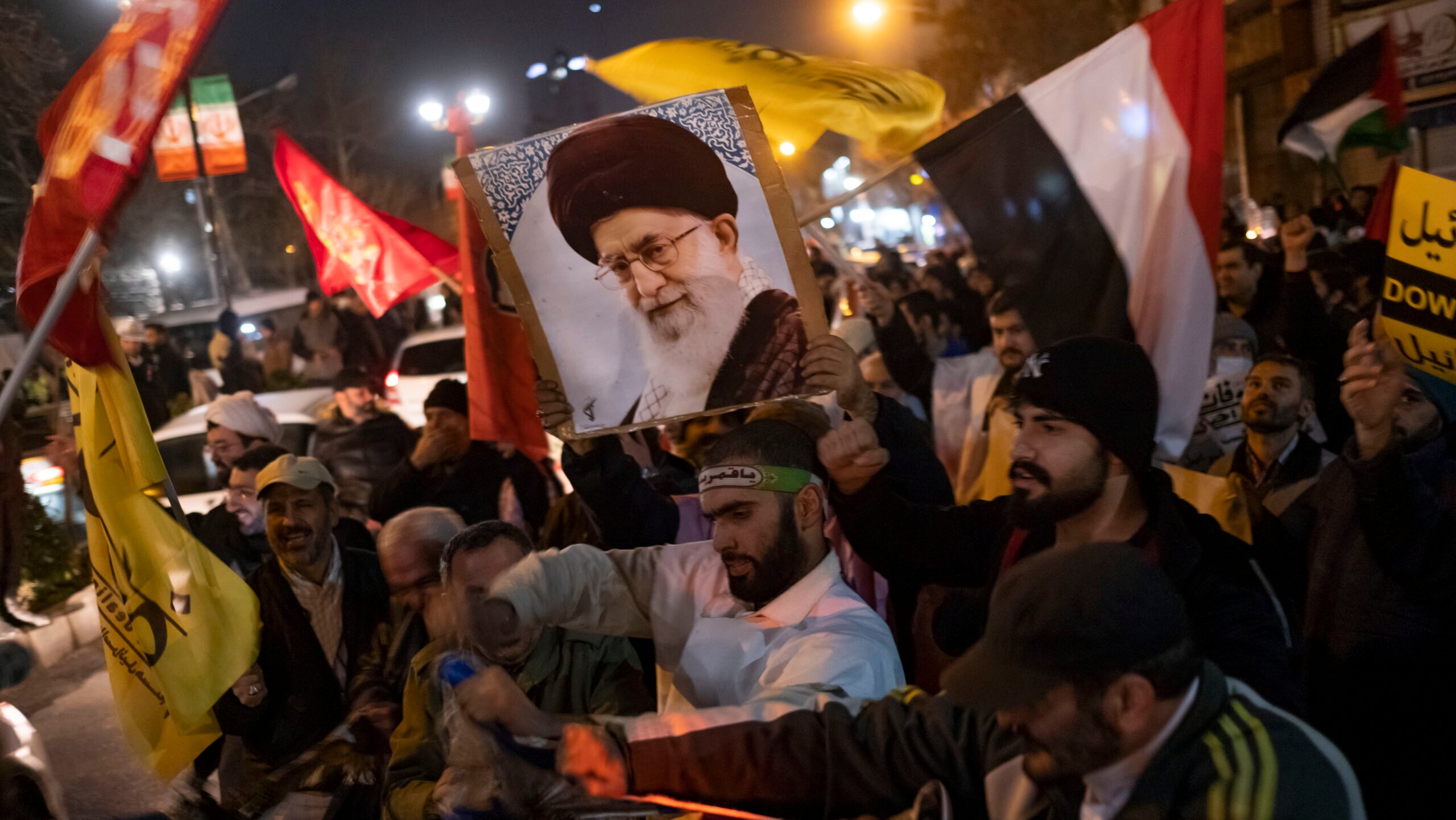
Iranian protesters are carrying a portrait of Iran’s Supreme Leader Ayatollah Ali Khamenei and a Yemeni flag as they tear an Israeli flag during an anti-U.S. and anti-British protest in front of the British embassy in downtown Tehran, Iran, on January 12, 2024. (Photo by Morteza Nikoubazl/NurPhoto via Getty Images)
WASHINGTON — Though Iran’s support for its proxies in the Middle East continues, a top US commander in the region said today Tehran is not courting a wider war.
“I do continue to assess that the Iranians are not interested in a broader regional conflict,” Air Force Lt. Gen. Alexus Grynkewich, commander of US Air Forces Central (AFCENT), said during a breakfast with reporters this morning hosted by the Defense Writers Group.
“They want to take advantage of the crisis as it exists, but they’re not interested in, you know, war with Israel, war with the United States, or war with anybody else right now,” he said.
But recent events, and ones looming, have officials on alert, Grynkewich cautioned. One chief concern is how Iran chooses to respond to what US officials said was an Israeli strike on an Iranian diplomatic compound in Damascus, Syria, that killed top Iranian military and intelligence officials. Iran has vowed a response and accused the US of complicity, Grynkewich noted, though he echoed Pentagon spokesperson Sabrina Singh when he said the US was “not involved at all” in the strike and was unaware of Israel’s specific military operations.
Should Iran’s response involve targeting US interests in the region — directly or, more likely, through its proxies — it would upend a tenuous dynamic in which US facilities have not been targeted by the proxies since the deaths of three American soldiers in a drone strike in Jordan in late January. Officials are continuing to monitor the situation after the Israeli strike in Damascus, though Grynkewich said he currently does not “see any specific threats right now to our forces.” (American warships continue to take out missiles, rockets and unmanned platforms launched into the Red Sea by the Iran-backed Houthis in Yemen.)
Looking ahead, another event that could escalate tensions further is Israel’s pledged invasion of the Palestinian enclave of Rafah in Gaza, where Jerusalem says the last stronghold of Hamas remains and must be destroyed. The situation has raised concerns from countries like the US and international human rights groups who warn the conditions in Rafah are dire, as Palestinians are functionally trapped in the city to which the Israel Defense Forces (IDF) previously encouraged them to flee.
Grynkewich emphasized he has no insight into the details of Israel’s plans for Rafah, and that the US does “not do any specific on the ground advising or helping them with targeting or anything like that.” But he cautioned that depending on how the operation in Rafah is executed, outcomes like mounting civilian casualties could have a “destabilizing effect” on the region.
“And that has long-term implications, not just for our security interest, but frankly, for the Israeli security in the region as well,” he said.
Scrutiny of Israel’s bombing campaign in Gaza has intensified particularly in the wake of an attack on aid workers with the World Central Kitchen organization and revelations about the IDF’s purported use of artificial intelligence. Asked about Israel’s protocols for its air campaign, Grynkewich said he personally witnessed operations in an IDF “strike cell” near the end of 2023, where he saw “no strike lists” and documented protected facilities.
“[I]t appeared to me they were doing all the things that we would do,” he said. “My assessment is they are, or were, making a bona fide effort to adhere to the law of armed conflict, and were doing that within the context of the conflict […] that they’re fighting it with the existential threat that they see themselves facing.”
On Israel’s northern border with Lebanon, Grynkewich observed that although Israel and Iran-backed Hezbollah have exchanged fire in the wake of the Oct. 7 Hamas attack, both sides have “stayed below the threshold of that breaking out into major conflict.”
Officials are also continuing to monitor the risk of escalation as those attacks continue, but Grynkewich’s assessment is that Hezbollah, like Iran, is not seeking a wider conflict.
Israel is, however, eager for a buffer zone along the Lebanon border, he said, adding that “there’s a lot of negotiations that I think have to happen to get us there. Some of those negotiations will play out in the military sphere before they start in the diplomatic sphere, I think.”
RELATED: ‘Not an exaggeration’: Fears rise of Israeli incursion into Lebanon to push back Hezbollah
And in the Southern Arabian Peninsula in Yemen, where the Iran-backed Houthi rebel group is still holding international shipping at risk, Grynkewich said the group has launched 75 missiles since November, spanning over 50 attacks that have affected 55 different countries.
The US has seen changes in the Houthis’ behavior, Grynkewich said, pointing to a drop off in large drone swarms that the group has difficulty sustaining. US-led strikes have additionally denigrated some of the Houthis’ capabilities, he added, though the extent is difficult to assess particularly given Iran’s continued replenishment of weapons.
For example, he said the Houthis “probably” had “dozens” of anti-ship ballistic missiles at the start of the conflict and have fired “dozens” of the missiles since, but “the rate of resupply is something that we’re trying to understand and trying to work with other components in CENTCOM [US Central Command] to stop.”
Task Force 99 And JADC2
Amid the various conflicts in the region, AFCENT has been utilizing new capabilities to bolster its operations, Grynkewich noted. One example is AFCENT’s Task Force 99, which he said has been working to field cost-effective drones that can assist with intelligence, surveillance and reconnaissance (ISR). Task Force 99 has “a couple of promising technologies” he declined to detail, though he said the task force’s capabilities have been used in combat in the region.
Additionally, Grynkewich said CENTCOM is making use of new Joint All Domain Command and Control (JADC2) capabilities, particularly a “min[imum] viable product” that helps construct a “common operating picture that pulls in feeds from everywhere.” Now, elements like AFCENT and its Navy counterpart can both view “the same basic picture” that in turn helps shape combat operations.
“You do have to understand the data that goes in there — what’s the source of the data? how confident are you in it? — but when you understand all of that, you can have that common picture,” he said. “And now you can make real time decisions in seconds about is a ship going to engage that, is a fighter going to engage it? Do we need to call one of our partners to warn them about it?”
CENTCOM is working with other partner nations in the region to construct a similar common operating picture on separate networks, and air defense liaisons are sharing information “so that they see the same thing or very close to the same thing that we’re seeing.” And looking ahead, he said it’s crucial to ensure large amounts of data can be transmitted quickly.
“[B]andwidth, bandwidth, bandwidth and secured access to the spectrum. That is going to be essential for things like JADC2 to come together,” he said. “You’ve got to be able to get massive amounts of data, or the information that you’re deriving from that data, rapidly and in near real time to every actor so that they’re seeing the same thing. And if you can’t do that, because you don’t have access to that bandwidth, either because you didn’t buy enough or because it’s being contested, then you’re stuck on the side of the road and not doing anything.”
Australia tops up Ukraine military aid with $100M
Australia has already supplied Ukraine with 120 Bushmaster vehicles, six 155mm howitzers, 56 M113 armored vehicles, 14 special operations vehicles and its signature cardboard drones.



























